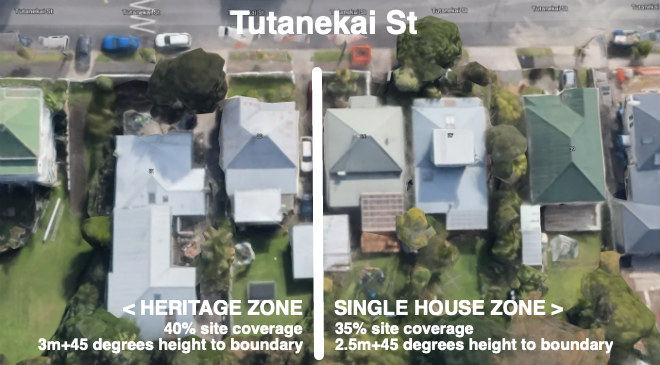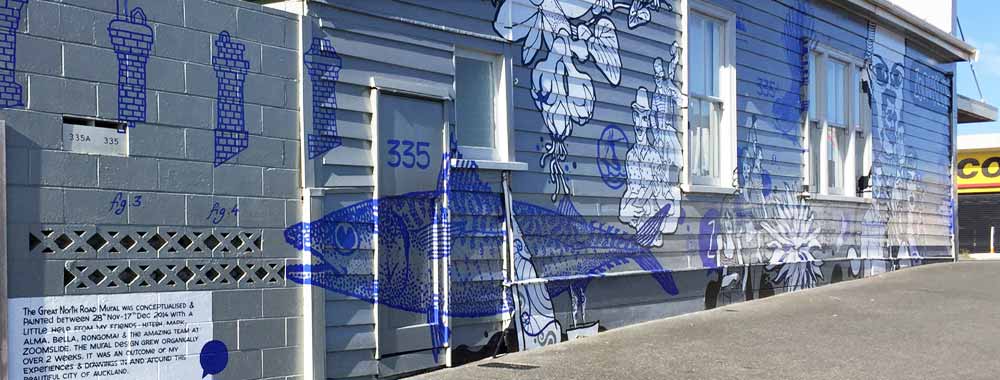
Auckland Council wants to change the Unitary Plan to make heritage zones more developer friendly. We need to know what you think. Read on, it’s important…
N.B. At the end of the article is a request for you to reply in the comments section with your feedback. We need to know whether you are in favour of the proposed changes or against, and would appreciate you putting aside a few minutes to give us your thoughts.
Auckland Council has written to some Grey Lynn residents saying it is “proposing to make changes to the Auckland Unitary Plan to clarify how the Special Character Areas Overlay works with the underlying zone in some areas of Auckland.”
Sounds innocent enough, right?
The letter has been sent only to those residents living in a zone that the proposed plan change applies to, i.e. what you and I know as heritage villa areas but what the bureaucrats call “Residential – Single House Zone” with a “Special Character Areas Overlay”.
Click here to read the full letter »
(PDF 1.6 MB. Click to open; right click to download.)
In a nutshell, the letter says they are proposing changes and invite submissions. But they don’t reveal what the actual changes are. And what they do say is obfuscated in bureaucratese.
Bureaucratese(noun) a style of language, typically used by bureaucrats, that uses jargon or euphemism to the detriment of broader understanding.
Here’s an example paragraph…
“Proposed Plan Change 26 relates to Chapter D18, Special Character Areas Overlay – Residential and Chapter E38, Subdivision – Urban of the Auckland Unitary Plan.”
Here’s another…
“The proposed plan change seeks changes to the Auckland Unitary Plan to make it clear that certain planning provisions of the Special Character Areas Overlay would prevail over the corresponding provisions of the underlying residential zones. The proposed plan change also refines some of the standards within the Special Character Areas Overlay, including height in relation to boundary, yards, paved areas and fences.”
They’re saying the proposed plan changes are to make things clear. Are you any clearer on what, exactly, the proposed changes are?
Us neither.
There is an attachment to the letter that goes into another 2+ pages of explanation and detail, once again without revealing any pertinent details.
There is a link to a page on the council’s website where they say, “the proposal may be inspected”. Except it’s not there. It’s buried another two levels deeper.
Even when you find it, there’s nothing there other than what’s contained in the letter that referred you there.
And here’s a link to the PDF that supposedly provides, “A bit more information about Plan Change 26” but contains nothing that wasn’t already covered in the letter: https://www.aucklandcouncil.govt.nz/plans-projects-policies-reports-bylaws/our-plans-strategies/unitary-plan/auckland-unitary-plan-modifications/proposed-plan-changes/Documents/bit-more-information-proposed-plan-change-26.pdf
Plain-English translation
Here’s my plain-English translation of the proposal… in Single House Zone areas that have a Special Character Areas Overlay in place, the rules for the Special Character Areas Overlay will REPLACE the rules in the underlying Single House Zone.
In other words, the heritage protection (i.e. Special Character Areas Overlay) will not place additional restrictions on the underlying zone, it will REPLACE the rules for the underlying zone.
Sounds innocent
This is why we’re so late in alerting you to this proposed rule change. It all sounds so reasonable. It is natural to expect the heritage rules would be more restrictive than the rules of the underlying zone, right?
That’s what many of us on the GLRA committee thought too, one member even writing that, “Under this re-write the stiffest rules apply”.
But after digging into it, we believe the letter is a wolf in sheep’s clothing. The devil is in the [concealed] detail. I’ll get to that shortly.
But first some background…
Why is the council proposing this plan change?
The council wants to make it clear which planning provisions apply when a property is zoned residential and also has a Special Character Areas Overlay. They say…
“Greater clarity will benefit people who want to develop their property, interested neighbours and the council’s team who assess resource consent applications.”
We beg to differ. We think it will definitely benefit developers and the council’s team, but most definitely not neighbours. Read on to find out why…
Why does it need clarifying?
There are a number of instances where there are equivalent provisions in both the Special Character Areas overlay and the underlying zones (e.g. height to boundary), which has led to conflict between the zone and overlay rules. Auckland Council says the Special Character Areas overlay is therefore not achieving its objectives.
Council taken to Environment Court
The proposed changes are a response to recent Environment Court decisions. Basically, the council was taken to Court and lost. Three times.
Auckland Council previously considered the Special Character Areas Overlay represented a ‘replacement package’ for development standards in the underlying Single House Zone.
The Environment Court didn’t agree with Council’s interpretation of the rules and declared that both sets of rules – the Special Character Areas Overlay and the underlying zoning rules – should apply when considering resource consent applications.
That obviously did not sit well with Council officers because the proposed plan change is intended to ensure their previous view prevails, i.e. that the Special Character Areas Overlay rules replace the underlying zoning rules.
The challenge of dealing with these issues is summarised at p. 26 of the Coombes & Williams Overlay Analysis Report, December 2018…
“It would not be appropriate to introduce a general rule that makes the overlay provisions always prevail over zone and Auckland-wide provisions. This would create issues when the overlay provisions are more permissive than their equivalents elsewhere in the plan, but the overall intent of the overlay is to be restrictive. In such cases the overlay is not meant to enable particular activities where there are other reasons for a zone to restrict that activity. Such an approach would create anomalous situations such as the Volcanic Viewshafts Overlay allowing building heights up to a sloping viewshaft height when the building height in the surrounding zone is lower.”
What Coombes & Williams say wouldn’t be appropriate… is exactly what Council is proposing.
Council’s letter to residents and the website links provided give absolutely no information about what the affected overlay rules and underlying zone rules are. It talks in general terms and at high level about the changes, but withholds the all-important detail.
This concerned us so we dug deeper to find out what is actually being proposed.
What we found was troubling…
The Devil
Bizarrely, the overlay rules are actually MORE PERMISSIVE in some cases. Yes, the heritage rules are more developer-friendly than the underlying Single House Zone rules!
For example, the Special Character Areas overlay rules allow for a “larger building envelope” (e.g. a bigger extension in your neighbour’s backyard) among other things.
Also, the council does not have to consider the effects on neighbours, which it does under the Single House Zone rules. The council has to consider the effects on the streetscape and character of the area, but not the neighbours.
I kid you not.
What is proposed?
The proposed change covers rules applying to…
- building height
- height in relation to boundary
- yards
- building coverage
- maximum impervious area
- landscaped area
- fences and walls
Building height
NOTE: This section was edited on 23 June following feedback. See note below.
- The height limit in the Single House Zone
is 8mand Single House Zone with Special Character Areas Overlay are both 9m. (This is made up of 8m plus a bonus of 1m for the roof, as long as no more than 50% of the height of the roof goes to 9m.) Council wants the more generous height limit of 9m to apply in heritage areas.This means that in a heritage zone (Single House Zone with Special Character Areas Overlay) a developer can build an extension in the backyard of the villa next door to you that is 9m high. If the developer does that in a non-heritage zone, they can only go to 8m.
Height to boundary
- The Single House Zone limit is 2.5m +45 degrees.
- The limit in the Single House Zone with Special Character Areas Overlay is 3m +45 degrees (for houses with <15m front boundary, which is most villas).
- Council wants the more generous limit of 3m +45 degrees to apply in heritage areas.
- This means that in a heritage zone a developer can build 3m high adjacent to your boundary. In a non-heritage zone they can only go to 2.5m.
- EDIT: “Adjacent to” does not mean “on” the boundary. In the Single House Zone the minimum permitted side yard is 1m vs 1.2m in the heritage zone. The heritage zone rule is equivalent to building 1.0m from the boundary at a height of 2.8m +45 degrees. So, a bit less than half a metre more permissive, but still much more generous than the non-heritage zone.
Building coverage
- Maximum site coverage in the Single House Zone is 35%.
- Maximum site coverage in the Single House Zone with Special Character Areas Overlay is 40% for sites 300-500 m2 (the majority of villa sites).
- Council wants the more generous limit of 40% to apply.
- This means a developer can build a bigger extension on the back of a villa in a heritage zone.
EDIT – 5:25 PM Sunday 23 June 2019
Following Beth Sullivan’s feedback in the comments section below, I spent several more hours trawling through all available information and compiled the following comparison table. Beth is partially correct…
The maximum height in particular is one I got wrong. I’m guessing the information I was referring to was either incorrect, or has been superseded.
In my defence, I am no planning expert and ended up having to research this with no help. I did my best and got some things right and some wrong. Thanks for prompting me to look deeper Beth 🙏😊
However, in other cases the overlay still appears to be more permissive than the underlying zone rules.
Some are of the view that this is perfectly okay because it’s just the old Res 1 rules. Others are of the view that the heritage rules should not be more permissive than the underlying zone rules. Let us know what you think in the comments below.
| Single House Zone | Heritage Zone (Single House Zone w/ Special Character Areas Overlay) |
|
| Building height | 9m (8m + 1m bonus for roof, subject to certain provisions) [Ref AUP H3.6.7] |
9m (8m + 1m bonus for roof, subject to certain provisions) [Ref PC 26, D18.6.1.1] |
| Height in relation to boundary | 2.5m + 45 degrees [Ref AUP H3.6.7] |
3m + 45 degrees on side & rear boundaries [Ref PC 26, D18.6.1.2] *MORE PERMISSIVE* |
| Yards – front | 3m [Ref AUP H3.6.8] |
The average setback of the 3 sites on either side, or 6 sites on one side. [Ref PC 26, D18.6.1.3] |
| Yards – side | 1m [Ref AUP H3.6.8] *MORE PERMISSIVE* |
1.2m [Ref PC 26, D18.6.1.3] |
| Building coverage | 35% [Ref AUP H3.6.10] |
40% [Ref PC 26, D18.6.1.4] *MORE PERMISSIVE* |
| Landscaped area or Landscaping | 40% [Ref AUP H3.6.11] |
33% [Ref PC 26, D18.6.1.5] *MORE PERMISSIVE* |
| Maximum impervious area | 60% [Ref AUP H3.6.9] |
65% [Ref PC 26, D18.6.1.6] *MORE PERMISSIVE* |
| Fences and walls | Front: 1.2m, or 1.8m for up to 50% and 1.2m for remainder, or 1.8m if at least 50% is visually open. Side & rear boundaries: 2m [Ref AUP H3.6.12] *MORE PERMISSIVE* |
Front boundary: max 1.2m high. Side boundaries of front yard: max 1.2m high. All other boundaries: max 2m high. [Ref PC 26, D18.6.1.7] |
| N.B. (1) This table applies to villa sites of 300m2-500m2 and with frontages <15m wide, i.e. the majority of villas in Grey Lynn. (2) If one rule is more permissive than the other, it is highlighted in green. If it is not possible to determine which rule is more permissive, or both are equal, neither is highlighted. |
||
The difficult thing here is weighing up the rights of property owners, who naturally want more permissive rules, and the rights of neighbours, who naturally want more restrictive rules. That’s one of the reasons we need your feedback.
Summary
In short, under the proposed plan change a developer will be able to build a bigger, higher, more dominant extension in a heritage area (e.g. 33 Tutanekai St) than in a regular Single House Zone (e.g. 35 Tutanekai St).
If a developer wants to build an extension 9m high, and 3m +45 degrees height to boundary, and 40% site coverage at 35 Tutanekai St (Single House Zone), the neighbour at 33 Tutanekai St will have to be considered.
But if a developer wants to build the same extension next door at 33 Tutanekai St (heritage zone, i.e. Single House Zone with Special Character Areas Overlay), the neighbour at 35 Tutanekai St gets no say.
Is that fair?
What do proponents of the rule change say?
Graeme Burgess of Burgess & Treep Architects, which specialises in heritage and residential architecture, says…
“The Plan Change is about ‘re-balancing’ and bringing the old Res 1 controls back into play… The rules are not ‘new’… this is a return to the old standards, not a whole new system”.
From the trenches
Louise Kelly and her husband Tarus live next door to one of the developments that sparked this whole controversy. Here’s what she says…
“The impact it has on the way you live your life is catastrophic. Our backyard would have been a quagmire in winter because of the shading, and in summer we wouldn’t even want to use it because of this towering structure looming over us.”
We urgently need to know what you think
Submissions close on Friday 28 June 2019. We need to know where you stand on this issue before we contemplate making a submission.
Please reply in the comments below with your feedback. Are you in favour of the proposed changes or against? Why? We need to know urgently and would appreciate you putting aside a few minutes to give us your thoughts.







Before any changes I definitely want more clarity of what these vague terms the council uses .. I suspect a wolf in sheep’s clothing
Sounds like destruction of our heritage neighbourhoods by stealth and subterfuge. I say: Fight it.
I am very concerned at this proposal. Based on current experience with AC, their officials are not transparent with affected residents and the community. I think it is really important to put in a submission stressing the importance of protecting heritage values and the need for plain English proposals to be prepared by the Council and that their letter and information is not acceptable as consultation. It is not good faith communication with the affected residents and community. Thank you for your work on this. Deborah
What a potential nightmare. This stealth by the Auckland Council must be stopped before it gets too late.
We already have a ruined West Lynn with unwanted redesigned curbs and planting and very reduced parking. The thought of houses being shaded from sun and light by oversized building additions will be the final insult to how we want to live in our leafy lovely suburb.
Our current Council and the Unitary Plan’s motto is “Density uber alles”
The Heritage dept doesnt fight for heritage, the Local Board doesn’t – its pretty much Mike Lee vs the Overdevelopers.
Fight it. And remind the Waitemata Local Cycling Board that they are overseeing the destruction of the most Heritage filled area in Auckland.
Unless thats their plan…
Hi Geoff, anyone who reads my monthly reports to the Local Board (see vernontava.com) would know that we spend a great deal of time and effort working to protect heritage in the area and keep a close eye on resource consents and planning developments. As far as I’m aware, no other local board member provides such a comprehensive report on resource consent matters. You’re welcome to give any examples that go beyond wild generalisations where the Local Board has not done so.
Ok – there is so much wrong with what you have written, but never let ignorance get in the way of a good rant eh! 1. The maximum height for the single house zone (SHZ) and the special character overlay is EXACTLY the same – 8m plus up to 1m for the roof form (basically the point at the top for a roof that is sloped on both sides). 2. The Special Character Overlay does not allow you to build to 3m at the boundary – buildings must be a minimum of 1.2m from the side boundary, 4m from the rear, and follow the existing set backs at the front.
This plan change is not creating new rules, or allowing additional development, it instead reinstating the SAME rules that have existed in our neighbourhood for the last 20 years, that council accidently screwed up when transitioning to the Unitary Plan (UP). Prior to the UP, planning rules were set under the previous councils’ district plans (DP) The Auckland DP has a special Isthmus A zoning area for GREY Lynn/Ponsonby. This recognised that lots in these historic suburbs tend to be much smaller and narrower than modern subdivisions, by allowing owners to
A)build to a height to boundary starting at 3m on boundary (same as current overlay rules!, but the DP only require 1m side yard)
B) smaller lots to build on greater proportion of the land. The DP used a different formula than the current overlay rules, but the effect was similar – you could build on 35% of a 500 sqm lot, 40 % on a 400 sqm lot, rising to 50% for a 200sqm lot.
These rules also reflected the existing historic building pattern – houses were traditionally built much closer and higher to the boundary, and were extended at the back over time.
The Auckland Council decided that for the Unitary Plan it wanted to simplify the large number of zones it inherited from the 6 District Plans. It did this by creating residential zones based on the primary housing types in each area e.g. single house zone, allowing 1 house per lot, or terraced housing and apartment zone etc. The single house zone set a minimum lot size of 600 sqm- a size rarely found in our historic neighbourhoods. (Note also that the SHZ also permits existing housing to be demolished as a right!)
Council still wanted to maintain the existing development rules for Ponsonby/Grey Lynn and other historic neighbourhoods – so did this by taking the previous zone rules and putting them into the Special Character Overlay. It was council’s intention that these rules would overwrite the zone rules, and I assume most people thought this – I certainly submitted to the UP stating that I was happy because the rules were not changing for my property in the special character area. To this end, council started approving consents for properties based on the overlay rules, from the time the Unitary Plan was operative, until Dec 2017, when it received advice that it was applying the rules incorrectly. In effect, the UP did not specify that the overlay rules overwrite the zone rules, therefore the Environment Court decided it must apply both set of rules, even though these conflict.
The effect was to render the overlay development rules redundant. This has had an absolutely devastating effect on people going through the planning process – designs that would have been permitted at any point in the last 20 years were suddenly not. Imagine being a homeowner, having invested thousands in architectural plans, surveys, and council consent fees and suddenly discovering it is all worthless. Imagine being a “developer” – mostly likely a small scale builder renovating a single house, who could be facing bankruptcy if the project falls over.
So council is now trying to fix this. The processed plan change merely adds a line to the Unitary Plan stating that the overlay rules will overwrite the zone rules, and tidies up a few minor issues like changing maxed paved area to impervious surface area. It does not add additional development rights – just continues the rules that have existed for 20 years.
So what should we think about the overlay planning rules? Personally I think they provide a good balance between protecting the existing heritage buildings while allowing a reasonable degree of development.
I think that if development was restricted to SHZ rules, then we’d lose more of our heritage buildings. Owners no longer able to build behind their existing house may instead choose to build over the existing, or seek permission to demolish entirely. And I have good reason to suspect this – I was caught up in the overlay issue. Our design was to build behind, leaving the existing house and lean too. We felt this was a good design – preserving the historic layout of our buildings. When the overlay issue came up, and council was discussing how to resolve it, they very clearly sugested that we look at demolishing the lean too, and building over the existing house to get within the 35% footprint!
Fortunately for us, we have already gained consent for our existing design (we were able to show the effects were less than minor) so the proposed plan change is of no benefit to us. But I think the plan change should be supported as it helps protect our heritage.
If people are concerned about buildings being demolished or new builds that are out of character then they should submit on those issues specifically rather than just opposing the plan change. Likewise, if you are concerned about the overlay rules and what they allow – identify the specify rules and why you disagree with them. This will have greater weight than just opposing the plan change generally.
Note – glba, I would be happy to write this an article for you 🙂
Beth Sullivan’s piece is compelling – can GLRA/Brandon Wilcox respond to help those of us who care but are more removed from recent personal involvement in the process? Being in Schofield Street where we are zoned without any protection and next to four recent brutalist concrete new builds it can look relatively unimportant!
Thanks Beth for adding a clear explanation of the situation and a dose of sanity. As you say: “This plan change is not creating new rules, or allowing additional development, it instead reinstating the SAME rules that have existed in our neighbourhood for the last 20 years…” I support the plan change.
Hi Beth, you have written a nicely worded letter but you are not correct in your statements Re height to boundary and set backs as to what council deem are to be notifiable to neighbours.
Happy to discuss and invite you to view what our neigbour was consented and we were unnotified.
021742560
I should clarify that I am not in any sense a planning expert – everything I have learned is from the process of trying to obtain consent, first under the DP, then the UP, then again when the overlay rules issue was discovered! But if anyone wants to review any of my points, the District Plan rules are still available online, as are the SHZ and overlay rules. The council also provides a design guide for the SHZ
Taurus – I can’t offer any specific advice for your situation. My understanding is that council can approve a consent without notification if the combined effects of the infringements is considered to be less than minor. (I have had this explained to me as meaning that the effects of the design are no more than those generated by a permitted design?) Maybe ask the council for a copy of the consent decision?
Thanks Beth for your excellent feedback. You are partially correct and I have edited the article accordingly, and also added a comparison table for quick visual reference of the differences.
Beth, thank you – and also Brandon – for raising the issue – and providing some clarity to some very confusing language. If the changes are as you say Beth, I do support them – as they allow people to make moderate changes to their houses. I love the mix of heritage and new builds in the area – and I live one over from town houses, which are themselves next to a five-story. I think you need a degree of density to support the cafes and shops that provide spaces for the community to come together. I like being in a mixed-use zone with a chance of working in walking distance to home. I am grateful for the new residents parking zone rules as it has stopped my street being used as a park and ride, and I can actually get a park close to my house again.
It sounds like another way that Auckland council is using to put protocol’s in place to increase their take over power of the Auckland community. It is public knowledge that the .Mayor Phil Goff wants to build Apartment buildings, and more business venues in the Grey Lynn area. They want to take over the Grey Lynn community to build a concrete Jungle. And make it part of CBD. That’s why they are charging for car parking, and started to remove the bus services in the area (which we have fought hard to restore and have been successful ). There are people who live in the area who support this slow take over. The bottom line is that the council wants to establish control over Grey Lynn land, because it is prime real estate. Making it difficult for the residents to live here,encourages residents to move. This gradually will allow council to have unchallenged development powers over the land in the Grey Lynn area and give them the power to make the money they wish to make out of the land in the area.
This is mostly incorrect. I have written an explanatory post here https://vernontava.com/2019/06/20/plan-change-26-to-auckland-unitary-plan/ and would also refer you all to the comments made above by Beth Sullivan who does a good job of describing what the plan change would achieve. Don’t panic; this plan change only seeks to correct an error made in the Unitary Plan process and essentially retains the rules we’ve had in place in the Res 1 zones for the last 20 years or so.
All the best,
Vernon Tava
Waitemata Local Board
Thanks for joining the conversation Vernon. I read your explanatory post before writing this article. It was very informative, and understanding the background to why the changes are being proposed was good, but I still had to do further research to establish what the actual rules were in each zone.
Beth’s comments were great. After analysing the points and doing even more research, I found I had got one thing wrong but the rest was spot on. See comparison table above. Therefore, my article appears to be mostly correct. I am very happy to be proven wrong though, so welcome any detail you can provide that substantiates your claim that the article is mostly incorrect.
Aye to all the above and furthermore, we wouldn’t be surprised if all planning applications under the new regulations are non-notifiable and by the time a neighbour hears about the next door’s proposal it will be too late anyway.
It is a farce to believe what council is stating. Clarity is sought in what is actually being envisaged as changes with clear and easily found answers to the questions. The problem remains that we are left confused and our rights are usurped by councils riding rough-shod over those of us affected. To what benefit and for whom I ask?
All these rules about distances from boundaries make me nervous for the people in the likes of Norfolk St and Lincoln St. You can barely squeeze between some of the houses they’re packed in so tightly. The same exists here and there in Grey Lynn – Cockburn St has a bunch; 19 & 21 Tutanekai St and 522 & 528 Richmond Road appear to be far too close for modern comfort.
Can anyone provide any clarity around the right (or lack of) to renovate a house to its original footprint, or rebuild completely if it is destroyed by fire, airplane crash, meteor, etc?
I have no issue with extensions being required to fit new requirements, but part of what gives Grey Lynn (and others) their character is precisely that they do not conform to the current rules!